-
Posts
12 -
Joined
-
Last visited
Content Type
Profiles
Forums
Blogs
Gallery
Events
Store
Posts posted by MonteSanto
-
-
Thanks for this invitation! tomorrow will be the day, I take time
 0
0 -
Good morning gents!
@ulsterman: I do not disagree with your statement and there have been some peculiar reasons. First, we Austrians always have been a " lazy sort of Germans with an attitude for individuality". Very often, you can see in this "tons of pictures" Austrians wearing both, because it looks fine and "more is sexy". Others, not so close to the new "brothers" refused the german badges and prefered the Austrian medal. There was also a slight "pressure" by the nazis, not to wear the Austrian "Kriegserinnerungsmedaille 1932" after the "Anschluss" and many of my countrymen did so, and of course many did not wear the german "HK" to show a certain "independance". Some continued to wear the forbitten official Austrian decorations from the First Republic.
I show you one of my favourite bars, of Oberst d. Gebirgstruppe Lagger (a professional soldier), who showed his individuality on his bar, not wearing any "rememberance" of the great war, no german long service cross ( he had more than 25 years and was awarded all 4 grades), but the Austrian of the Republic or "Bundesstaat" (Federal state). Even he did not wear all of his bravery awards (Signum Laudis silver + bronce), no KTK, but the Austrian Cross for military merit III.cl (ÖMVK3; 4th in row). Even on the very rare "Orden der Württembergischen Krone", knight´s cross with spades (350 awards in WW1, app.10 to Austrian), he put a greater emphasis and due to regulation, this award should be behind the highest Austrian award (EKO III.cl).
So, especially in Austria regulations (concerning orders & decoration, uniforms aso...) always have been violated, this was a tradition until nowadays

This is not a lone example, so in this respect nothing was impossible and individuality was everything.
Greetings from Vienna
0 -
19 hours ago, bcalkins said:
MonteSanto,
Welcome to the forum!! That is very interesting information about the tunic.
Do you have an K.u.K. era caps you can post?
Best regards
Hello bcalcins,
as I am focused on the inter war period, those kuk caps are trading stuff to me, and they always find a new home very quickly. I dont want to bore anybody, so if there is an interest for Austrian bundesheer of the interwar period, I can send some pictures within a few days (due to a busy week).
greetings from Vienna
0 -
Hello gents!
what you see in this picture is a policeman, serving in the Police dept. City of Innsbruck, Tyrol around 1930. There have been a few cities in Austria without a " Bundespolizeidirektion" ( City Department of the Federal Police) , but with the right for a local police, not a "Gendarmerie" .
So you find on the top of the cap, the colors of the Tyrol (red-white) and in the lower badge the crest of Innsbruck ( showing an heraldic bridge over the Inn, transl.: Inn-bridge
Blazon: „A shield Gules with a bridge Argent, seen from above, resting on two pilings.“ The arms of Innsbruck are canting, showing a bridge (Brücke) over the Inn river. The oldest known use of the arms dates from a seal of 1267. Both the bridge and the river were shown rather differntly than at present. The present composition is used since 1325. The colours are known since 1547 and the arms thus have never changed since..
https://goo.gl/images/sV5XWY here the crest of Innsbruck.
The uniform indeed was the basic sample of the Police and "Sicherheitswache" ( dark green blouse, "Paroli" in "krapprot", the buttons indicate a candidate, cap also dark green and " krapprot" piping, trousers black with "krapprot" piping). The cross-strap belongs to the holster of his Steyr M1912 gun ( worn like within the kuk army in WW1).
Don't know if anybody is interested after almost 9 years

cheers from Vienna!
0 -
On 03.07.2017 at 20:18, johannis said:
Hello Andreas.
Again, many thanks, for the quick but above all excellent help.
Best regards, Jannis.Hello gents!
After 8 months, I hope it is of any interest...
Unfortunately I have to disagree:
If the displayed orders all (one is to much) belong to the bar, then it should be an officer´s clasp.
The German "Kriegsverdienst Kreuz" in gold looks a little bit to high, because it was named the "Pour le Merite" of NCO´s and soldiers. It was awarded only around 1750 times in WW1 and I can not remember any Austian award. So perhaps this is a copy and wrong here and should be a EK II or "Kriegsverdienstmedaille" (if awarded for an officer-candidate)
So, also the Austrian Merit Crosses of course have been awarded to officers. Mostly to officers away from the frontline, to military officials, doctors, priests a.s.o.
According to the German law "Verordnung zur Ausführung des Gesetzes über Titel, Orden und Ehrenzeichen" from 14. November 1935 (RGBl. I, page 1341 f), § 14 "Trageweise der Orden und Ehrenzeichen" ( range of wearable orders) it should be:
1. The german award with the EK II - ribbon
2. The first in line of the displayed Austrian awards is the "Bronzene Militaerverdienstmedaille" (Military Medal of Merit in bronce) , because awards for bravery went first and this medal only was awarded to officers,
3. then the "Goldenes Verdienstkreuz mit der Krone" (golden merit cross + crown),
4. "Silbernes Verdienstkreuz mit der Krone" ( silver merit cross + crown),
5. the next should be the KTK ("Kaiser Karl Truppenkreuz", trooper cross of Karl),
6. then the HK 1934 ("Ehrenkreuz des Weltkriegs" of course with swords),
7. then the "medal for wounded" (if...),
8. and at last the German medal for the "occupation of Austria" (Medal 13.th march 1938).
The "Eisernes Verdienstkreuz" (iron merit cross), which in fact was very low and I have doubts, if any of them have been awarded to officers (perhaps only if he was officer candidate), and there is no ribbon for it.
The bar is due to regulations after the "Anschluss 1938", saying, that the highest German award is first, then the Austrian ones. The "Wound medal" (no longer mentioned in this law) should have been changed to the German pin-badge, this was the regular procedure, but in Austria, many times the regulations have been ignored. Even the way of arranging the single ribbons is contrary to the common manner of this period. It should be of the "bow-shape", the displayed one is very "old fashioned" like a few decades ago.
So I hope, I could give you additional informations.
Greetings from Vienna
0 -
On 23. August 2017 at 03:32, Bayern said:
Hello : I believe that the man of the right is a feldwebel . the lace on the collar patch is barely visible , and he carries a officers sword. the two men probably belongs to a unit of sappers . they wears jackboots , without spurs .
Hi gents!
Bayern you are right, this is a Feldwebel, but notice the cuff- stripe, so it is clear, that especially he is a Waffenmeister ( armorer ). According to regulations, this stripe is like the csako-braid for a Korporal ( 40 mm yellow silk, 2 black 1 mm stripes along the end each 2 mm far from the end), worn on both arms.
greetings from Vienna!
On 24. August 2017 at 01:29, Farkas said:Nice Faehnrich ( ensign)
0 -
Plze notice, that the multiple stamped tunic is original before 1918, that without is the similar " Lambert Hofer" after '45 like Skip's ( Numbers of quoting changed)
my iPad is very hard to handle
 0
0 -
On 8. März 2018 at 18:28, skippy said:
greetings bcalkins and Bayern
Thank you for your responds. I didn't reply sooner as I was down with my health.
I had no idea that the regiment can be identified by the color of the collar, cuffs. I think that Bayern might be on to something as the collar, cuffs color does match the remaining once light blue on my tunic. Not saying that bcalkins is wrong, his description was in detail and very usable. Yes bcalkins, you are right my tunic is before 1908.
I went a step further and since I know that Germans, Austrians and so fourth are very particular in having the correct historical uniforms for "schuetzen fest - carnival" and so on (as I lived there for some time) I went to Ytube and looked up the uniform described by Bayern. The same uniform was present in one of the fests and I could now see what type of full dress uniform was for my tunic with hat and trousers.
They had many Austro - Hungarian uniforms including the "Wiener regiment Number 4" which looked identical to my tunic except the collar, cuffs blue was to dark. There are also old movies from the 40's-50's that have the same coloring as mine. It is worth looking at.
After looking at this I do believe that the tunic is from "Kuk Infantry Regiment Hoch und Deutschmeister Number 4". I however didn't know that Germans carried the same white stars or stars at all on the collar as is on my tunic. I thought this was more of stickily "Austro - Hungarian" thing. I was wrong.
I wish to thank you both for your assistance and time.
Skip
Hi Skip, I hope your health is not endangered after reading this:
this tunic is from the stock of " Lambert Hofer of Vienna", a specialist on movie-equipment und for theater. There is a very famous Music band in Austria, which is uniformed like the "house-regiment" of Vienna, the IR 4 " Hoch und Deutschmeister". After WW1 the band became a civil istitution and was very popular until nowadays. Many famous band leaders have been engaged and the band still exists today.
In the first years the wore the original AH uniforms, but they expired more and more an are still encountered.
your item is approximately from the fifties or early sixties of the 20th century. ( Mine: picture 2). Lambert Hofer always got the worn out tunics for movie- purposes ond indeed, you see them in old Austrian movies. The way of producing is very similar to the old manner, but it lacks the imperial quality because of tailor's Skills and costs. Some indications: the stars are Made of modern plastic like those ones for the Austrian Army after 1955. Even the collar lining ( white sewn-on) is very movie-like. The private made tunics provided usually not the "potato-sack-cotton" like the official army stock( here much finer and with a wide array of stamping and marking ( picture 1),
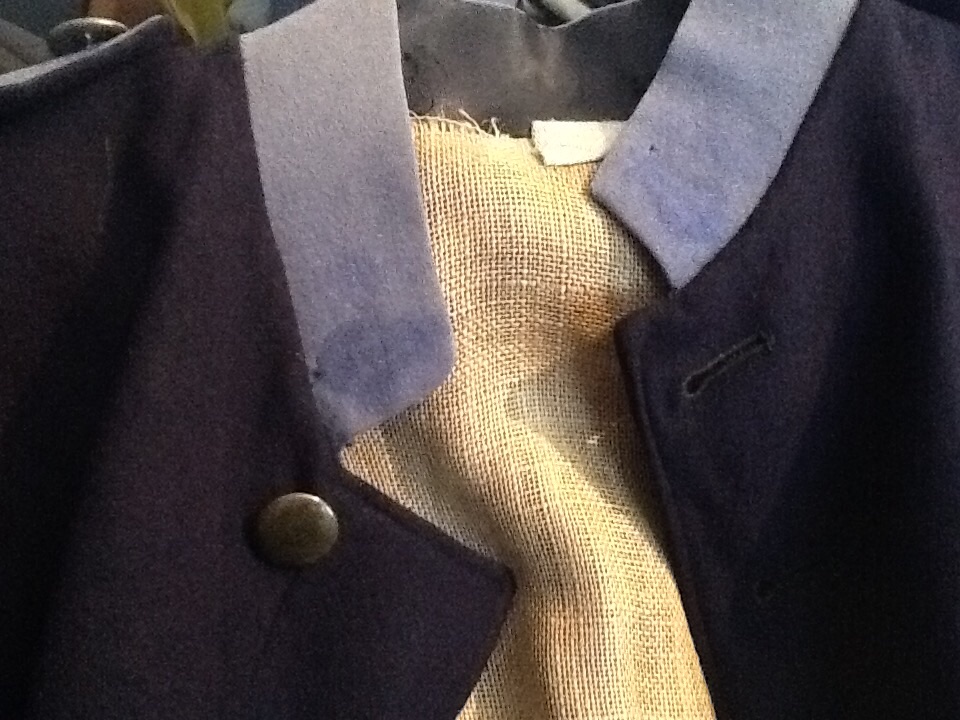 but were lined usually with black cotton (picture 3)
but were lined usually with black cotton (picture 3)
Bayern did well by considering the facing color as " Himmelblau" (sky-Blue), here, because of the bad " after-war-quality" it faded to a similarity of pike gray and are sold at flea-markets to the beginners, as IR 49 the " Hesser" of Sankt Poelten.
Hope, I could help!
Greetings
0 -
I hope you get my text, because my text programme tries to change my english to german, if I dont pay attention
0 -
On 18. September 2017 at 23:11, bcalkins said:
Hmm, I don't know what those sleeve chevrons are for. But those stars look like the enlisted bone/celluloid stars. I don't think they would have reflected so much light if they were the officer style bullion stars.
So if they are indeed enlisted stars, his highest rank could be a Cadet Sergeant.
The chevrons indicate a NCO who is prolonging his duty free-willing. 3 years additional enlistment is indicated by a 13 mm wide golden braid an a second of 6 mm width. So 6 years are one 13 mm and two 6 mm, 9 years one 13 mm and three of 6 mm. Here it ends.
Privates and privates 1st class arme indicated by braids made of yellow silk, 10 mm widme with a centered black stripe of 2 mm. 1 for 3 years, Theo 2 for 6 and 3 for 9 ( maximum). These stripes are also sewn on in the manner, prescribed before and the sample is the same like the indicating stripe for " 1 year's volunteer" (but here radial).
greetings from Vienna
0 -
Hallo Gentlemen! recently came across this forum and it was quite interesting what you are discussing. I collect Austrian Military items since I am 16, so this is about 41 years. I concentrate on the Austrian Bundesheer, which was out armed Force in the interwar period.
To contribute in your discussion, I give you a few samples of Austrian Rank stars:
1st column: OR, NCO
row1: bone (worn & mint)
row2: celluloid
row3: cardbox
row4: silk
row5: silk with ornaments
2nd column: CO, NCO (OCandidats), State officials
row1: CO "white" (silver, mint& worn)
row2: CO "yellow" ( Gold, both worn)
row 3: metal, Gold-plated (Offiziersstellvertreter, " Master-sergeant(?)")
metal, silver-plated (Fähnrich, ensign)
row 4: State-officials, silver, gold ( "Rosette")
3rd column: Military- officials ("Sternrosette" 4-Rays and 6-rays)
row1: Officer' rank, "yellow" and " white" stitched
row2 + 3: NCO Ranks, Metal plated, silk
row 4 : CO-Ranks (6-rays)
row 5: NCO- ranks, silk ( 6-Rays)
I hope you find this useful & I'm looking forward to discussing with you!
greetings from Vienna
0




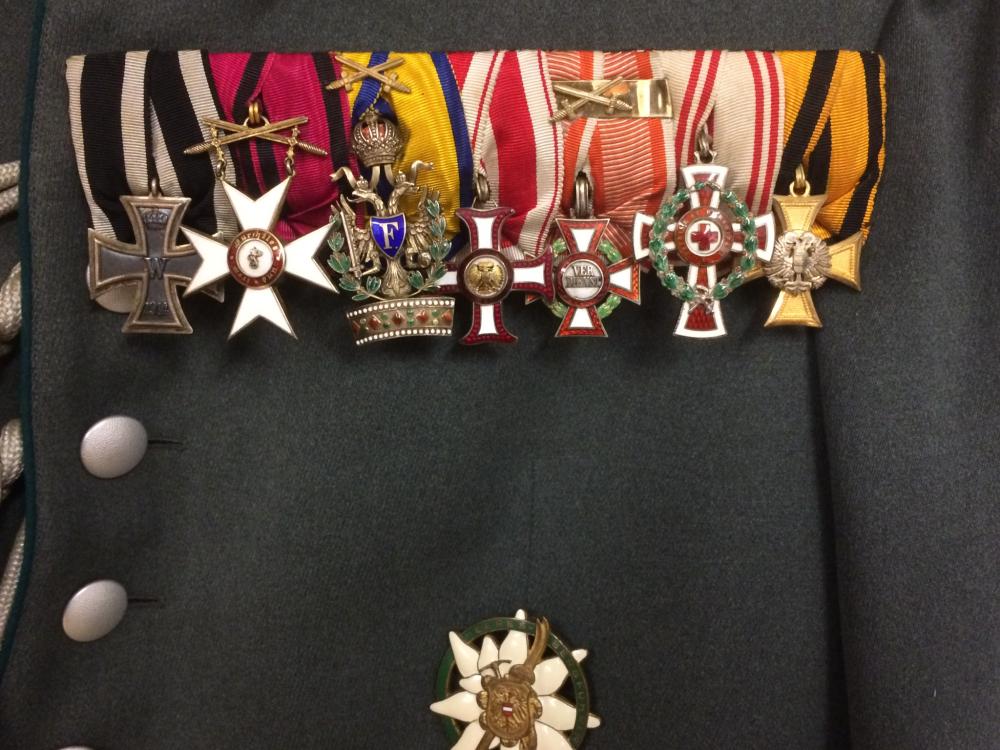
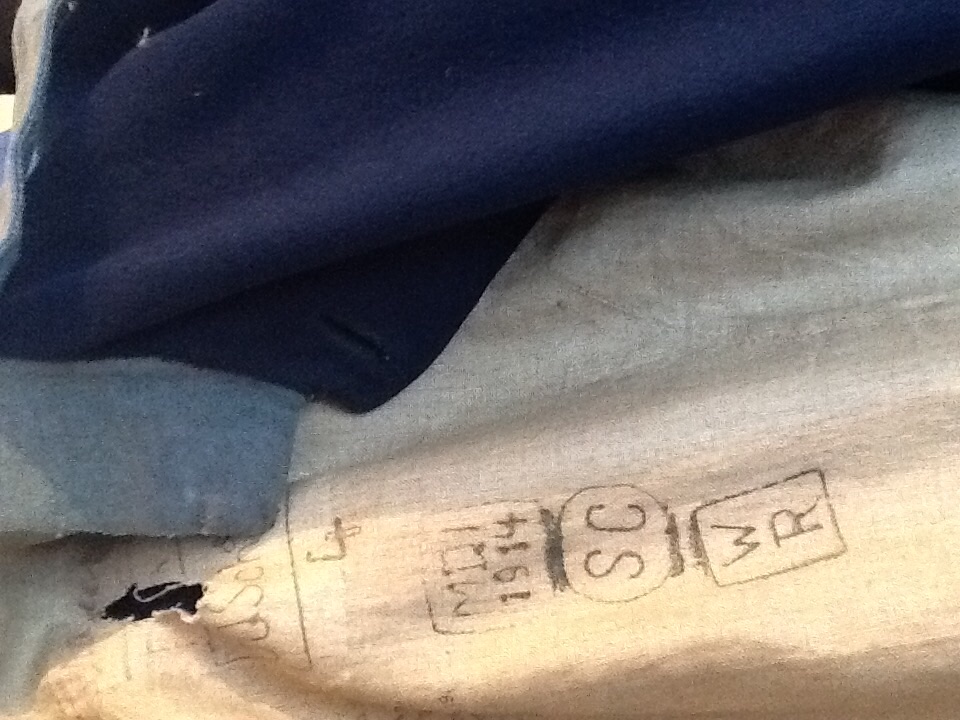
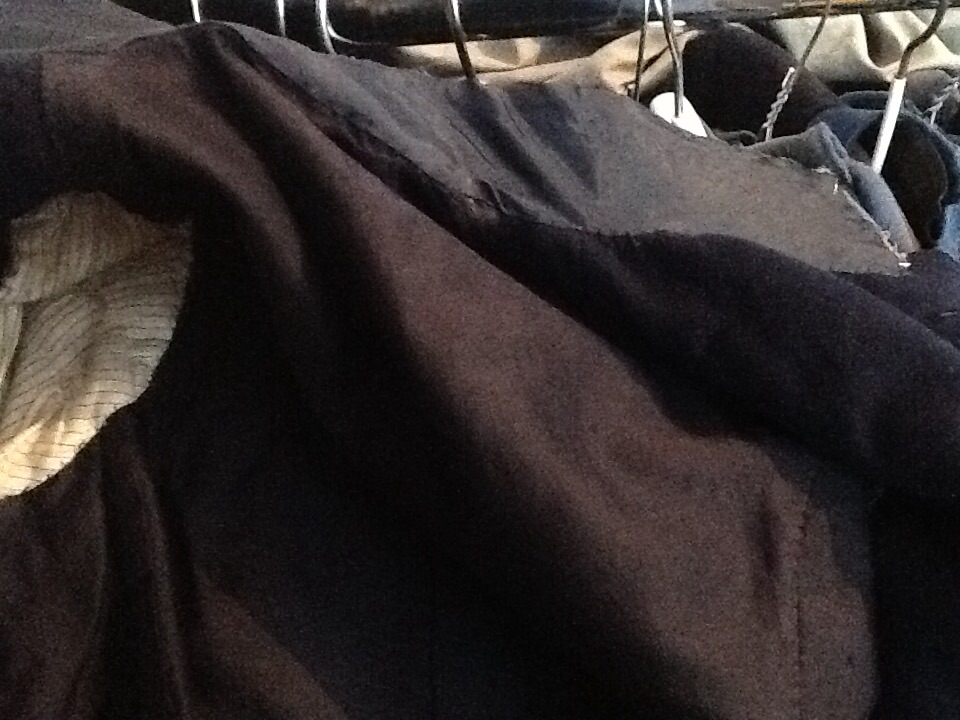
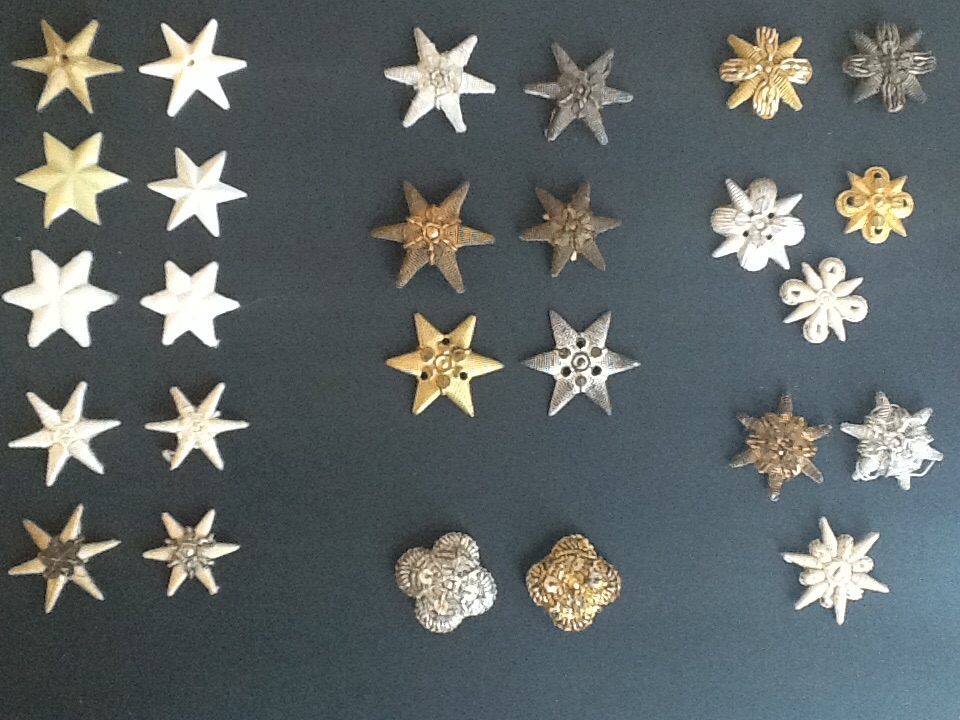
Prussian medal bar with Austrian medals.
in Germany: Imperial: The Orders, Decorations and Medals of The Imperial German States
Posted
I´ll post better quality, when my influenza is over.
"week" greetings, Harry